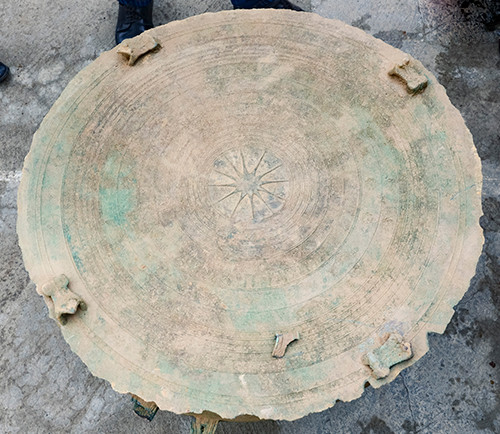Bronze drums dating back to 2,000 years were discovered in Dien Bien
The drum weighs about 20kg, 49cm high, 61cm in diameter, still quite intact. On the surface of the drum, there are 4 groups of single toad, located distributed, evenly spaced 4 corners, counterclockwise.
The ancient bronze drum in Dien Bien was discovered by Lo Van Viet (residing in Pa Ngam 1 village, Nua Ngam commune, Dien Bien district) on January 21 while working on a field near Huoi Hoa slit (about 1 block from Pa Ngam village). 2km).

The newly discovered bronze drum in Dien Bien weighs about 20kg, height 49cm, surface diameter of 61cm.(Photo: Khanh Chi).
Mr. Viet said, when hoeing a hoe to the ground heard a clang, he discovered a metal block. In it, he heard the sound of the metal being hollow inside, so he dug up and brought it to the government. The leader of Nua Ngam commune immediately announced the incident to the Heritage Department (Department of Culture - Sports and Tourism of Dien Bien province).
According to preliminary assessment of Dien Bien Provincial Museum, artifacts are a bronze drum weighing about 20kg. The drum surface is quite intact, face diameter is 61cm, height is 49cm. On the surface of the drum, there are 4 groups of single toad, located distributed, evenly spaced 4 corners, counterclockwise. The middle of the drum is the 12-pointed star symbol, which can symbolize for 12 months of the year or used to measure the time of the ancients. Many patterns such as rice, peanuts . were also discovered on the surface of this drum.
Based on the above factors, Director of Dien Bien Provincial Museum Trinh Thi Mai said, initially it can be said that this is a drum in the drum line Heger 3 (also known as Shan drum ) originating from Caren people red in northeastern Myanmar, dating back about 2,000 years ago. However, in order to prove the origin and origin of the drum, it is necessary to continue to study the cultural and historical values of artifacts before making a report to the Ministry of Culture.
The fact that this drum has a round shape while the elliptical bottom is very different from other bronze drum objects discovered earlier.
According to experts, it is necessary to study carefully to determine whether this is an inherent form of drum or deformed due to being in the soil for a long time.
- Detecting human bones in 2,000-year-old bronze drum
- Detecting bronze drums in Bac Can
- Quang Nam: discovering two ancient bronze drums
- Detecting ancient bronze drums at the foot of Ru Than mountain
- Three blocks of bronze drums in Hoa Lu Ancient Capital were discovered
- 10 iconic images in Dien Bien Phu victory
- There was a 3.9-magnitude earthquake in Dien Bien province
- Three blocks of bronze drum can not be more than 1,000 years old
- Flooding caused much damage in Dien Bien province
- 6 wonderful things that made Dien Bien Phu campaign shaken the globe
- Discovered a 200-year-old bronze cannon of the coast
- Discover the ancient city dating back to 5,000 years in Israel
 Discovered an ancient centipede fossil 99 million years old
Discovered an ancient centipede fossil 99 million years old Discovered bat-like dinosaurs in China
Discovered bat-like dinosaurs in China Discovered a 200-year-old bronze cannon of the coast
Discovered a 200-year-old bronze cannon of the coast Discover 305 million-year-old spider fossils
Discover 305 million-year-old spider fossils